CONTACT INFORMATION
Quezon City Disaster Risk Reduction and Management Office
- QCDRRMO
- Quezon City Hall, Kalayaan Avenue, Diliman, Quezon City
- 8988-4242 local 8038, 8928-4396
- qcdrrmo@quezoncity.gov.ph
- Official Facebook Page of Quezon City Disaster Risk Reduction and Management Council
Office Hours
Always Open
ABOUT US
Description
Republic Act 10121, or the “Philippine Disaster Risk Reduction and Management Act of 2010,” was developed based on past disaster experiences, focusing on a national approach to mitigation, preparedness, and prevention. It institutionalized a national disaster risk reduction and management plan and allocated necessary funds. Executive Order No. 23, series of 2010, furthered this by establishing the Quezon City Disaster Risk Reduction and Management Council (QCDRRMC) to address local disaster needs, redefining its functions, and reorganizing its structure. The QCDRRMC aims to become a global model of disaster risk reduction, fostering a sustainable, resilient, and future-ready Quezon City.
Through a science-based and data driven approach in addressing the challenges in Quezon City, its mission is to implement and inclusive DRRM that builds resilience in local communities. The QCDRRM Council pledges to focus on disaster preparedness, prevention, and mitigation while maintaining integrity, professionalism, and effective communication in all its services.
Mission
To operationalize an effective, efficient, and inclusive DRRM system dedicated to Resilience-building in Quezon City communities.
Vision
A global mode of excellence in Disaster Risk Reduction and Management for its cohesive DRRM system fostering a Sustainable, Future-ready, and Resilient Quezon City.
Legal Bases
- Republic Act 10121
- Otherwise known as the “Philippine disaster risk reduction and management act of 2010”
- EO 23 s 2010
- Organizing the Quezon City Disaster Risk Reduction and Management Council (QCDRRMC), redefining its functions, providing for its composition and for other purposes, pursuant to R.A. No. 10121.
- SP 2290 s2014
- An ordinance creating the Quezon City Disaster Risk Reduction and Management Office (QCDRRMO), defining its function, duties and responsibilities, providing for its composition, appropriating funds thereof and for other purposes.
- SP 2424 s2015
- An ordinance amending ordinance No. SP-2290, 2014, to correct the position titles, qualification standards and salary grades of the technical staff of the Quezon City Disaster Risk Reduction and Management Office (QCDRRMO), pursuant to joint memorandum circular No.2014-1 and other penitent Civil Service Commission circulars.
- SP 3170 s2023
- An ordinance amending section 1 of ordinance no. SP-2424, s2015, reorganizing its organizational structure, creating an additional fifty-one (51) plantilla positions and absorbing four (4) plantilla positions from Disaster Control Division (DCD), Department of Public Order and Safety (DPOS) to the Quezon City Disaster Risk Reduction and Management Office (QCDRRMO), and appropriating fund therefor.
Service Pledge
To serve with honor, integrity and professionalism;
Provide adequate information and resolving issues promptly and accurately;
Provide feedback mechanism and immediately respond to complaints;
Be timely and prompt in delivering of our services;
Treat everyone with respect, fairness, dignity and non- discrimination;
Attend to all requesting parties who are within the premises of the office prior to the end of official working hours and during lunch breaks.
SERVICES
OPERATIONS AND WARNING SECTION SERVICES
EMERGENCY MEDICAL SERVICES (EMS) AND SEARCH AND RESCUE (SAR)
WHO MAY AVAIL:
Quezon City Constituents and other interested parties.
REQUIREMENT:
- Request letter or phone call
PROCESSING TIME:
- Call through the emergency hotline and accept phone call: 5 minutes
- Discussion on incident situation and patient’s information: 5 minutes
MANAGEMENT TIME:
- Patients or Incident assessment providing immediate care: 10 minutes
- Patients transfer to the Hospital: 10 minutes
AMBULANCE TRANSFER OR STAND BY
WHO MAY AVAIL:
Quezon City Constituents and other interested parties
REQUIREMENT:
- Request letter or phone call
PROCESSING TIME:
- Accept and record letters: 5 minutes
- Coordination with Hospital, Patient status and fit to travel: 5 minutes
MANAGEMENT TIME:
- Patients/Incident/s assessment providing immediate care: 10 minutes
- Patients transfer to the Hospital: 10 minutes
REQUEST OF CCTV FOOTAGES
WHO MAY AVAIL:
Quezon City Constituents and other interested parties
REQUIREMENT:
- Request letter or phone call
PROCESSING TIME:
- Accept and record letter: 5 minutes
- Approval from the Head, QCDRRMO: 5 minutes
- Reviewing or Giving of copies of CCTV footages provided it will not be used for legal purposes: 20 minutes
INSPECTION OF HAZARD AND NON-HAZARD AREAS
WHO MAY AVAIL:
Quezon City Constituents and other interested parties
REQUIREMENTS:
- Request letter or phone calls
PROCESSING TIME:
- Accept and record letter: 5 minutes
- Approve and endorse the request letter to the Operations and Warning Section: 5 minutes
- Coordinate with requesting party for pertinent information related to the letter: 5 minutes
- Conduct inspection on site and submit report: 1 day
ADMINISTRATIVE AND TRAINING SECTION SERVICES
ORIENTATIONS, DRILLS, TRAINING, ETC.
- Orientation on Disaster Preparedness
- Quezon City Initiatives & Programs
- Earthquake Drill Evaluation
- Basic First Aid and Basic Life Support
- CBDRM Training (Community-Based Disaster Risk Management)
- ELSAROC Training (Earthquake and Landslide Search and Rescue Orientation Course)
- Other training and services related to DRR
- Basic Boat Handling / Water Search and Rescue (WASAR)
SCHEDULE OF AVAILABILITY OF SERVICE:
Monday to Friday
WHO MAY AVAIL:
Quezon City Constituents and other interested parties
REQUIREMENTS:
- Request letter or thru email at qcdrrmo@quezoncity.gov.ph
- Formal Request Letter (scheduled at least 3 days ahead of requested date) and provided there are no previous reports scheduled on the same date
PROCESSING TIME: 20 Minutes
RESEARCH AND PLANNING SECTION SERVICES
REQUEST FOR DRRM-RELATED DATA AND MATERIALS
SCHEDULE OF AVAILABILITY OF SERVICE:
Monday to Friday
8:00 a.m. to 5:00 p.m.
WHO MAY AVAIL:
General Public
REQUIREMENTS:
- Request letter:
- Full name and affiliation (e.g. school) of the requesting party
- Purpose
- Contact details including email of the requesting party
- List of specific data and template to be requested
- Properly accomplished Data Request Form
- Other documents, if applicable, such as:
- List of guide question
- Survey forms
PROCESSING TIME: 3 Hours and 40 Min
REQUEST FOR INTERVIEW OR STUDY TOUR
SCHEDULE OF AVAILABILITY OF SERVICE:
Monday to Friday
8:00 a.m. to 5:00 p.m.
WHO MAY AVAIL:
General Public
REQUIREMENTS:
- Request letter:
- Full name and affiliation or school of the requesting party
- Purpose
- Contact details including email of the requesting party
- Proposed time and schedule of interview or study tour
- Other documents, if applicable, such as:
- List of guide questions
- Survey forms
PROCESSING TIME: 25 Minutes
REVIEW AND APPROVAL OF THE BARANGAY DISASTER RISK REDUCTION AND MANAGEMENT PLAN (BDRRMP)
SCHEDULE OF AVAILABILITY OF SERVICE:
Monday to Friday
WHO MAY AVAIL:
Barangay Officials and authorized individuals
REQUIREMENTS:
- Proposed Barangay Disaster Risk Reduction and Management Plan for the upcoming year
- One copy of approved BDRRMP of the previous year (and the current year, if the request pertains to a review of the amended BDRRMP)
- Annual report on the utilization of the BDRRMP fund of the previous year with a copy of the inventory purchased equipment and conducted trainings/seminar charged against the BDRRM fund
- Legal instrument adopting the BDRRMP (e.g. Executive Order, Resolution)
- Legal instrument creating BDRRMP Committee
- Hazard, Vulnerability and Risk Assessment
- The HVRA with the evacuation and hazard maps should be updated at least every three (3) years (i.e. population, recommendations, and community-initiated efforts)
PROCESSING TIME: 1 Hour
PROGRAMS
“NEW NORMAL” PREPAREDNESS FOR THE RAINY SEASON AND IN FIRE SITUATION
As a Gawad KALASAG awardee, QCDRRMO leads the effort to review its preparedness measures for the rainy season and response protocols for fire situations and thus adopted a set of “New Normal” protocols for strengthening the capacities of communities to anticipate, cope, and recover from possible losses and adverse impacts in emergencies during the rainy season and in fire situations.
FREE, SAFE, AND SECURE TRANSIT OF COVID-19 PATIENTS
Since the beginning of the pandemic, the City Government through QCDRRMO has been transporting suspected and confirmed COVID-19 cases to and from homes, hospitals, and community caring facilities. In addition to the transportation services provided by the Barangay Health Emergency Response Teams (BHERTS), QCDRRMO provides free ambulatory services around the clock to ensure safe transit for suspected and confirmed COVID-19 cases and prevent further transmission among patients.
LOGISTICS
Since February 2020, aside from being the Training Facility of QCDRRMO, the Regional Evacuation Center has also been the hub for the City’s logistical supplies to effectively respond to COVID-19. The Logistics and Training Section provides support to all the offices in the City Government, QC-Owned Hospitals, 142 Barangays (which includes Special Concerned Area Lockdown), Isolation Facilities, Community Based Testing Sites, Vaccination Sites, National Government Offices, and Private Institutions.
MAINSTREAMING DRRM
DRAINAGE MASTERPLAN
QCDRRMO leads the partnership with the University of the Philippines – Resilience Institute in developing a Drainage Master Plan (DMP) for the City. The DMP project seeks to develop and select the best solutions, such as physical modifications and upgrades, necessary for drainage and flood management improvements in Quezon City.
The DMP covers all of the City’s 142 Barangays and integrates all 44 tributaries and five major river systems that pass through the City’s jurisdiction with the man-made drainage systems built by the various Government agencies involved with drainage and roadworks. It is noted that the DMP also covers flooding and other drainage challenges experienced at the City’s borders with its adjacent LGUs.
BARANGAY DRRM PLAN MENTORING
The QCDRRM Council is recognized as leading the country for two (2) years in a row in terms of DRRM- CCA. The City leads by example to other LGUs in terms of proactiveness in DRRM and in building resilience for the communities. In keeping up with this standard, the QC DRRM Office ensures that Barangay DRRM Committees within the city are also able to keep a certain standard in DRRM to effectively anticipate, cope, and recover from the impacts of emergency occurrences and disasters at the local level. QCDRRMO mentors the BDRRMCs through quality-based local DRRM planning and budgeting so that they may be able to efficiently carry out their responsibilities and duties in preparing for any hazard.
CONTINGENCY PLANNING
QCDRRMO initiated the formulation of Contingency Planning to strengthen the City’s resilience against natural or human-induced disasters by identifying the vision, policy framework, and strategies capitalized on disaster risk reduction and management in Quezon City. The Contingency Plan details the standard response operations during a worst-case scenario for hazards such as earthquakes, flooding, and stampede, following the prescribed revised guidelines of the Office of the Civil Defense.
PUBLIC SERVICE CONTINUITY PLANNING
QCDRRMO developed a Public Service Continuity Plan consisting of internal capacities and recovery requirements, as well as providing operational actions, processes, and strategies that will be carried out by Offices and Departments under the local government of Quezon City in case a disruption on government practices, system, and processes occurs.
FACILITATING RISK ASSESSMENTS
The conduct of Risk Assessments within the Local Government, particularly in barangays, is regularly facilitated and supervised by the QCDRRM Office alongside its partners in the Prevention and Mitigation Committee.
LDRRM PLANNING
The preventive approach serves as a reference for the development of the City’s Local Disaster Risk Reduction and Management Plan (LDRRMP) and the implementation of disaster risk reduction and management at a local level.
TRAINING EFFORTS
The QCDRRMO organizes and conducts training, orientations, and knowledge management activities on DRRM at the local level. Since its establishment in 2015, the QCDRRMO has led in the implementation of the training program for DRRM in the communities and city government, along with spearheading the conduct of earthquake drills across the city, honing communities on their preparedness for earthquake hazards.
CONTRIBUTION TO PLANS OF OTHER CITIES
QCDRRMO conducted a Community-Based Risk Reduction and Management (CBDRRM) Workshop in 2019. The said training was attended by different barangay personnel and community people from different cities in Metro Manila. The workshop aimed to teach the participants of the workshop the importance of CBDRRM in the community and equip them with basic knowledge of the CBDRRM and how to cascade the knowledge they acquired in their respective communities.
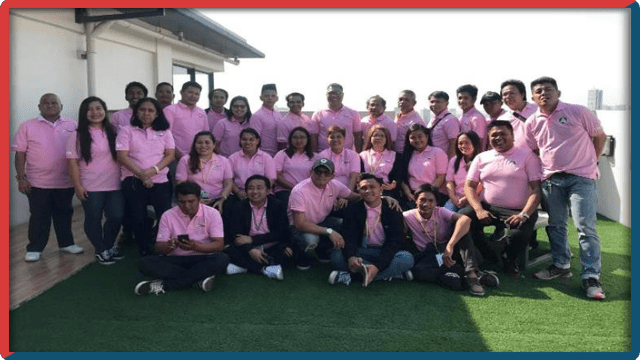
GUIDES
WHAT TO DO IN CASE OF TROPICAL CYCLONE
Mga Dapat Gawin Kapag May Bagyo
For emergency, call:
Para sa emergency, tumawag sa:
- Helpline 122
- 8988-4242 local 8038
- Emergency Operations Center: 0947-885-9929; 0947-884-7498
Tropical cyclone is an extreme weather condition characterized by large scale circulation of strong winds, low atmospheric pressure and heavy rains. It can cause flooding, storm surge, landslides and flash floods.
BEFORE
- Monitor the news for weather updates, warnings and advisories.
- Know the early warning and evacuation plan of the community.
- Check the integrity of your house and repair weak parts.
- Prepare your family’s GO BAG containing items needed for survival.
- Put livestock and pets in safe area or designated evacuation site for animals.
- When notified, immediately go to the designated evacuation center.
DURING
- Stay calm. Stay indoors and tune in for latest news and weather updates.
- Turn off main electrical switch and water valve.
- Use flashlight or emergency lamp. Be cautious in using candles and gas lamps.
- Stay away from glass windows.
AFTER
- Wait for authorities to declare that it is safe to return home.
- Stay away from fallen trees, damaged structures and power lines.
- Do not go sightseeing as you may hinder the work of the emergency services.
- Be cautious in checking and repairing the damaged parts of your house.
- Check for wet or submerged electrical outlets and appliances before turning on electricity.
- Throw away rainwater in cans, pots, and tires to prevent breeding of mosquitoes.
Ang bagyo ay isang uri ng lagay ng panahon na nagdudulot ng malalakas at mabilis na hangin at pag-ulan na maaaring maging sanhi ng matitinding pagbaha, daluyong ng dagat at pagguho ng mga lupa.
BAGO ANG BAGYO
- Alamin ang balita tungkol sa panahon at mga anunsyong pangkaligtasan.
- Alamin ang plano ng komunidad sa pagbibigay-babala at paglikas.
- Suriin ang bahay at kumpunihin ang mga mahina o sirang bahagi nito.
- Ihanda ang Emergency Go Bag na naglalaman ng first aid at iba pang kagamitan ng pamilya.
- Ilikas ang mga alagang hayop sa ligtas na lugar.
- Kapag inabisuhan ng barangay o lokal na pamahalaan, mabilis na lumikas sa itinakdang evacuation center.
HABANG BUMA-BAGYO
- Manatiling mahinahon. Manatili sa loob ng bahay o evacuation center at makinig sa pinakabagong balita at taya ng panahon.
- Patayin ang main switch ng kuryente at valve ng tubig, kung kinakailangan.
- Gumamit ng flashlight o emergency lamp. Maging maingat sa paggamit ng kandila o gasera.
- Umiwas sa mga salamin at bintana.
PAGTAPOS NG BAGYO
- Hintayin ang abiso ng kinauukulan kung ligtas nang bumalik sa tahanan.
- Umiwas sa mga natumbang puno, nasirang gusali, at linya ng kuryente.
- Huwag gumala upang hindi maabala ang emergency services.
- Maging maingat sa pagkukumpuni o pag-aayos ng mga nasirang bahagi ng bahay.
- Siguruhing walang basa o nakababad na outlet o kagamitan bago buksan ang linya ng kuryente.
- Itapon ang mga naipong tubig sa lata, paso, at gulong upang hindi pamahayan ng lamok.
WHAT TO DO IN CASE OF EARTHQUAKE
Mga Dapat Gawin Kapag May Lindol
For emergency, call:
Para sa emergency, tumawag sa:
- Helpline 122
- 8988-4242 local 8038
- Emergency Operations Center: 0947-885-9929; 0947-884-7498
An earthquake is a sudden and rapid shaking of the ground caused by the shifting of rocks deep beneath the Earth’s surface. Earthquakes can cause significant damage to buildings, roads, and infrastructure, and they can trigger landslides, tsunamis, and other natural hazards. It is important to be prepared and to know the safety measures to take during and after an earthquake to protect yourself and your family.
BEFORE
- Know the hazards in your area.
- Familiarize yourself with the following:
- Fire extinguishers (Mga pang-apula ng apoy)
- Medical kit (Mga gamit pang-medikal)
- Exit routes (Ligtas na daanan palabas ng gusali)
- Evacuation plan (Plano sa paglikas ng mga tao)
- Check your house and have it repaired if necessary.
- Store harmful chemicals and flammable materials properly.
- Secure heavy furniture and hanging objects.
- Prepare your family’s Emergency Go Bag containing items needed for survival.
- Participate in office and community earthquake drills.
DURING
WHEN INSIDE A BUILDING “DUCK, COVER, AND HOLD”:
- Duck under a strong table and hold on to it. Stay alert for potential threats.
- Stay away from glass windows, shelves and heavy objects.
- After the shaking stops, exit the building, and go to the designated evacuation area.
WHEN YOU ARE OUTSIDE:
- Move to an open area.
- Stay away from the buildings, trees, electric posts and landslide prone areas.
- If you’re in a moving vehicle, stop and exit the vehicle.
AFTER
- Stay alert for aftershocks.
- Assess yourself and others for injuries. Provide first aid if necessary.
- Prioritize the needs of older persons, pregnant women, PWDs and children.
- If in a coastal area and there is a threat of a tsunami, evacuate to higher ground immediately.
- Check for spills of toxic and flammable chemicals.
- Stay out of the building until advised that it is safe to return.
- Check for damages in water and LPG leaks.
Ang lindol ay biglaan at mabilis na pagyanig ng lupa na dulot ng paggalaw ng mga bato sa ilalim nito. Ang mga lindol ay maaaring magdulot ng malaking pinsala sa mga gusali, kalsada, at imprastruktura, at maaari rin itong magdulot ng mga landslide, tsunami, at iba pang mga likas na panganib. Mahalaga na maging handa at malaman ang mga hakbang na dapat gawin sa panahon ng lindol para maprotektahan ang iyong sarili at pamilya.
BAGO ANG LINDOL
- Alamin ang mga sumusunod:
- Fire extinguishers
- Medical kit
- Exit routes o Ligtas na daanan palabas ng gusali
- Evacuation plan o plano sa paglikas ng mga tao
- Siguruhinng matibay ang bahay at ipakumpuni ang mga sirang bahagi nito.
- Ayusin ang pag-iimbak ng mga nakakalasong kemikal at mga bagay na pwedeng maging sanhi ng sunog.
- Siguruhing ligtas ang mga pagkakalagay ng mga mabibigat at mga nakabiting bagay.
- Ihanda ang Emergency Go Bag na naglalaman ng mga pangangailangan ng pamilya.
- Makilahok sa mga Fire Drill o pagsasanay tungkol sa lindol.
HABANG LUMI-LINDOL
- Yumuko at magtago sa ilalim ng matibay na mesa at kumapit sa mga paa nito. Manatiling alerto sa mga banta ng panganib sa paligid.
- Umiwas sa mga bintanang salamin, mga aparador, at mabibigat na gamit na pwedeng mahulog.
- Matapos ang pagyanig, agad na lisanin ang gusali at pumunta sa nakatakdang evacuation area.
- Lumayo sa mga gusali, puno, poste, at mga lugar na may panganib ng lupa.
- Kapag nagmamaneho, itabi at ihinto ang sasakyan at lumabas.
PAGTAPOS NG LINDOL
- Suriin ang iyong sarili at mga kasama kung may tinamong sugat o pisikal na pinsala. Magbigay ng paunang lunas kung kailangan.
- Unahin ang mga pangangailangan ng mga matatanda, buntis, may kapansanan, at mga bata.
- Kung nasa tabing dagat at may banta ng tsunami, agad na lumikas papunta sa ligtas at mataas na lugar.
- Suriin kung may natapong nakakalasong kemikal at mga bagay na maaaring pagmulan ng sunog.
- Huwag bumalik sa loob ng gusali hanggang walang abiso na ligtas na ito.
- Suriin ang mga linya ng tubig at kuryente para sa maaring pinsala. Suriin din ang tangke ng gas o LPG.
WHAT TO DO IN CASE OF FIRE
MGA DAPAT GAWIN KAPAG MAY SUNOG
For emergency, call:
Para sa emergency, tumawag sa:
- Helpline 122
- 8988-4242 local 8038
- Emergency Operations Center: 0947-885-9929; 0947-884-7498
A fire emergency is any unplanned event that involves fire, threatening life, property, and the environment. It can range from a small, contained fire to a large, uncontrollable blaze. Immediate action is required to prevent injury, loss of life, and significant damage.
IN CASE OF FIRE
- Stay calm and evacuate immediately.
- Sound the fire alarm and call emergency hotlines for assistance.
- If you’re in a building, use the stairs and do not use elevators.
- Before opening doors, check handle first. If hot, DO NOT OPEN as the room may already be on fire.
- If there is smoke, get down low and cover your mouth and nose with damp cloth.
- If your clothes catch fire, STOP running, DROP on the floor, and ROLL to put out the flames.
- If trapped, stay in the room and signal for help using bright-colored cloth at the window or make noise.
- After the fire, do not return inside your house or building unless authorities deemed it safe.
- Have yourself checked for injuries.
Ang fire emergency ay maaaring magmula sa maliit na apoy hanggang sa malaking sunog. Kailangan ng agarang aksyon upang maiwasan ang pinsala, pagkawala ng buhay, at malaking pagkasira.
KAPAG MAY SUNOG
- Manatiling mahinahon at agad lumikas.
- Patunugin ang fire alarm at tumawag sa emergency hotlines para sa agarang tulong.
- Kung nasa boob ng isang gusali, gumamit ng hagdan sa paglikas. Huwag gumamit ng elevator.
- Bago buksan ang anumang pinto, pakiramdaman muna kung ito ay maiinit. Huwag buksan kung ito ay mainit dahil maaaring may sunog na sa boob nito.
- Kapag may makapal na usok, gumapang papunta sa ligtas na lugar. Takpan ang bibig at ilong ng basang tela o damit.
- Kapag nasusunog ang damit, sundin ang “Stop, Drop, and Roll,” tumigil sa pagtakbo, dumapa, at magpagulong-gulong hanggang maapula ang apoy.
- Kapag hindi makalabas, manatili sa loob at humingi ng tulong gamit ang tela na may matingkad na kulay o gumawa ng ingay para marinig ng mga rescuers.
- Pagtapos ng sunog, huwag bumalik sa loob ng bahay o gusali hanggang wala pang abiso ang kinauukulan.
- Ipasuri ang sarili kung nasugatan o nasaktan.
WHAT TO DO IN CASE OF FLOOD
Mga Dapat Gawin Kapag May Baha
For emergency, call:
Para sa emergency, tumawag sa:
- Helpline 122
- 8988-4242 local 8038
- Emergency Operations Center: 0947-885-9929; 0947-884-7498
A flood is when water overflows onto normally dry land, often due to heavy rain, river overflow, or dam failure, causing damage and risks to people and property.
BEFORE
- Stay indoors and continue to listen to weather updates.
- Prepare the Emergency Go Bag with food, water, medications, and a first-aid kit.
- Create an evacuation plan and identify safe locations where the family can evacuate.
DURING
- Stay on higher grounds.
- Stay indoors and stay tuned for the latest news and weather updates.
- Do not touch electrical equipment if you are wet or standing in floodwater.
- Do not go swimming or boating in swollen rivers.
- Do not cross streams when the water level is already above the knee.
- Do not walk or drive through flooded areas.
AFTER
- Do not open the main electrical switch or use appliances and other equipment until inspected by an electrician.
- Clean anything that may be contaminated by floodwater.
- If evacuated, do not return to your home or flooded areas until authorities declare it safe.
Ang baha ay nangyayari kapag ang tubig ay umaapaw sa karaniwang tuyong lupa, kadalasang dulot ng malakas na ulan, pag-apaw ng ilog, o pagkasira ng dam, na nagdudulot ng pinsala at panganib sa mga tao at ari-arian.
BAGO BUMAHA
- Manatili sa loob ng bahay at patuloy na makinig sa ulat ng panahon.
- Ihanda ang Emergency Go Bag na naglalaman ng pagkain, tubig, mga gamot, at first-aid kit.
- Gumawa ng evacuation plan at alamin ang mga ligtas na lugar kung saan maaaring lumikas ang pamilya.
HABANG MAY BAHA
- Manatili sa mas mataas na lugar.
- Manatili sa loob ng bahay at patuloy na makinig sa ulat ng panahon.
- Huwag hawakan ang mga kagamitang de kuryente kung ikaw ay basa o nakatayo sa tubig baha.
- Huwag lumangoy o mamangka sa umaapaw na ilog.
- Huwag tumawid ng sapa o ilog kung lagpas tuhod na ang tubig.
- Huwag maglakad o magmaneho sa lugar na baha.
PAGTAPOS NG BAHA
- Huwag muna buksan ang main switch ng kuryente o gumamit ng appliances at iba pang kagamitan hanggang sa masuri ng isang electrician.
- Linisin ang anumang bagay na maaaring kontaminado ng baha.
- Kung lumikas, huwag bumalik sa tahanan o sa mga lugar na binaha hanggang hindi ito naideklarang ligtas ng mga awtoridad.
PREPARING AN EMERGENCY PREPAREDNESS BAG
Paghahanda ng Emergency Go Bag
For emergency, call:
Para sa emergency, tumawag sa:
- Helpline 122
- 8988-4242 local 8038
- Emergency Operations Center: 0947-885-9929; 0947-884-7498
An emergency go bag is a kit with essential supplies you can quickly grab during emergencies or evacuations, such as food, water, medications, and important documents. Regularly update your go bag, checking expiration dates on food and medications, and rotate items as necessary.
THINGS TO PACK IN AN EMERGENCY GO BAG
- First Aid Kit
- Band-aid, alcohol, personal medicines, paracetamol, ointment, betadine, sterile gauze, medical tape.
- Food
- Bottled water, canned goods, biscuits, eating utensils.
- Clothing
- Clothes (good for 2-3 days), slippers, blankets, jacket, underwear.
- Tech Equipment
- Flashlight, powerbank, extra batteries, extension cord, charger.
- Toiletries
- Soap, Shampoo, toothbrush, toothpaste, tissue paper.
- Identification
- ID and important documents.
Ang emergency go bag ay isang kit na naglalaman ng mga mahahalagang kagamitan na madaling makuha sa panahon ng mga sakuna o paglikas, tulad ng pagkain, tubig, gamot, at mahahalagang dokumento. Regular na i-update ang iyong go bag, i-check ang expiration dates ng pagkain at gamot, at i-rotate ang mga bagay kung kinakailangan.
MGA DAPAT LAMANIN NG EMERGENCY GO BAG
- First Aid Kit
- Band-aid, alcohol, personal na gamot, paracetamol, ointment, betadine, sterile gauze, medical tape.
- Pagkain
- Bottled water, canned goods, biscuits, mga kagamitan sa pagkain.
- Damit
- Mga damit (sapat para sa 2-3 araw), tsinelas, kumot, jacket, underwear.
- Tech Equipment
- Flashlight, powerbank, extra na batteries, extension cord, charger.
- Toiletries
- Sabon, Shampoo, toothbrush, toothpaste, tissue paper.
- Pagkakakilanlan
- ID at mahahalagang dokumento.
WHAT TO DO IN CASE OF LANDSLIDE
MGA DAPAT GAWIN KAPAG MAY PAGGUHO NG LUPA
For emergency, call:
Para sa emergency, tumawag sa:
- Helpline 122
- 8988-4242 local 8038
- Emergency Operations Center: 0947-885-9929; 0947-884-7498
A landslide is the movement of soil, rocks, mud or debris down a slope. This can be caused by continuous heavy rains (rain-induced landslides) or shaking due to earthquake (earthquake-induced landslides).
BEFORE
- Know the landslide prone areas and learn the early signs of impending landslides.
- Monitor the news for weather updates, warnings and advisories.
- Prepare your family’s Emergency Go Bag containing items needed for survival.
- Know the location of the evacuation site and the fastest and safest way to go there.
- When notified by local officials, immediately evacuate to safer grounds.
DURING
- When inside a house or building and evacuation is not possible, stay inside and get under a sturdy table.
- When outside, avoid affected areas and go to a safer place.
- When landslide cannot be avoided, protect your head.
- When driving, do not cross bridges and damaged roads.
AFTER
- Leave the evacuation area only when authorities say it is safe.
- Avoid landslide affected areas.
- Watch out for possible flashfloods due to clogging of creeks or rivers.
- Check for missing persons and report it to authorities.
- Bring the injured and sick to the nearest hospital.
- Check your house for possible damages and repair as necessary.
- Report fallen trees and electric posts to proper authorities.
Ang landslide o pagguho ay ang pagbaba ng lupa, bato, putik at iba pang bagay mula sa mataas na lugar. Ito ay maaaring mangyari kapag may malakas at tuloy-tuloy na pag-ulan o pagyanig mula sa lindol.
BAGO ANG PAGGUHO NG LUPA
- Alamin ang mga lugar na may banta ng pagguho ng lupa at alamin ang mga palatandaan nito.
- Alamin ang balita ukol sa panahon at mga anunsyong pangkaligtasan.
- Ihanda ang Emergency Go Bag na naglalaman ng mga pangangailangan ng pamilya.
- Alamin ang lugar na paglilikasan at ang pinakamabilis at ligtas na daan patungo dito.
- Kapag inabisuhan ng kinauukulan, mabilis na lumikas sa ligtas na lugar.
HABANG MAY PAGGUHO NG LUPA
- Kapag nasa loob ng bahay o gusali at hindi posible ang paglikas, manatili sa loob, at magtungo sa ilalim ng matibay na mesa.
- Kapag nasa labas, umiwas sa gumuhong lupa at magtungo sa mas ligtas na lugar.
- Kung hindi maiiwasan na tamaan ng gumuguhong lupa, protektahan ang sarili.
- Kung nagmamaneho, huwag dadaan sa mga tulay at nasirang kalsada.
PAGTAPOS NG PAGGUHO NG LUPA
- Lisanin lamang ang evacuation area kapag ligtas na ayon sa kinauukulan.
- Umiwas sa mga lugar na may pagguho ng lupa.
- Kung malapit sa estero maging alerto sa posibilidad ng biglaang pagtaas ng tubig.
- Alamin kung may nawawalang kaanak o kakilala at agad na i-report sa kinauukulan.
- Dalhin sa pinakamalapit na ospital ang mga nasugatan at may karamdaman.
- Suriin ang bahay kung may mga nasira at ipaayos ang mga ito kung kailangan.
- Ipagbigay-alam sa kinauukulan ang mga natumbang puno at poste ng kuryente o telepono.
Department Directory
Enp. Ma. Bianca D. Perez, MPA
Local Disaster Risk Reduction and Management Officer
DRRM Building, Quezon City Hall Kalayaan Avenue, Diliman
8988-4242 local 8038
oth.qcdrrmo@quezoncity.gov.ph
Divisions/ Sections
| SECTIONS | OFFICER NAME | OFFICE ADDRESS | CONTACT INFORMATION |
| Administration | Mahed C. Alawi, CPA, MMPA Acting Deputy Chief for Administration | 3rd floor, DRRM Building, Kalayaan Ave. Diliman | 988-4242 loc. 8038 adminfinance.qcdrrmo@quezoncity.gov.ph |
| Operation | Erwin Carlos N. Valdez R.N. MPA Acting Deputy Chief for Operation | 4th floor, DRRM Building, Quezon City Hall | 988-4242 loc. 8038 qcdrrmo@quezoncity.gov.ph |
| Administration and Training Section | Mahed C. Alawi, CPA, MMPA Acting Chief, Administration and Training Section | 3rd floor DRRM Building, Quezon City Hall | 988-4242 loc. 8038 qcdrrmo@quezoncity.gov.ph |
| Finance and Property Section | Andrew Michael B. Alcid Acting Chief, Finance and Property Section | 3rd floor DRRM Building, Quezon City Hall Compound | 988-4242 loc. 8038 QCDRRMO@quezoncity.gov.ph |
| Research, Planning and Special Project Section | Donnie Ray D. Marquez Acting Chief, Research, Planning and Special Project Section | 3rd floor DRRM Building, Quezon City Hall | (02)8-710-1469 rp.qcdrrmo@quezoncity.gov.ph |
| Operation and Warning Section | Ronald Allan T. Datiles R.N. Acting Chief, Operation and Warning Section | 3rd floor DRRM Building, Quezon City Hall | 988-4242 loc. 8038 Ops.qcdrrmo@quezoncity.gov.ph |
Emergency Operations Center | Carl Oliver M. Luces Emergency Operations Center, Manager | 3rd floor DRRM Building, Quezon City Hall | 988-4242 loc. 7245 Eoc.qcdrrmo@quezoncity.gov.ph |
SPOTLIGHT
NON-COVID INCIDENT RESPONSE
- IRISE-UP (INTELLIGENT, RESILIENT & INTEGRATED SYSTEMS FOR THE URBAN POPULATION)
The iRISE-UP is the QCDRRMO’s integrated ICT solution that integrates monitoring systems of the City’s early warning devices, remote sensors, data loggers, and field equipment dedicated for monitoring of water levels in the rivers and observation of weather parameters such as rainfall amount, temperature, pressure, humidity. The system includes the collection and processing of data from early warning devices, remote sensors, data loggers, and field equipment dedicated for monitoring of water levels in the rivers and observation of weather parameters such as rainfall amount, temperature, pressure, humidity through the use of state-of-the-art Geographic Information Systems (GIS) Technologies and an IP-based public paging and alarm system.
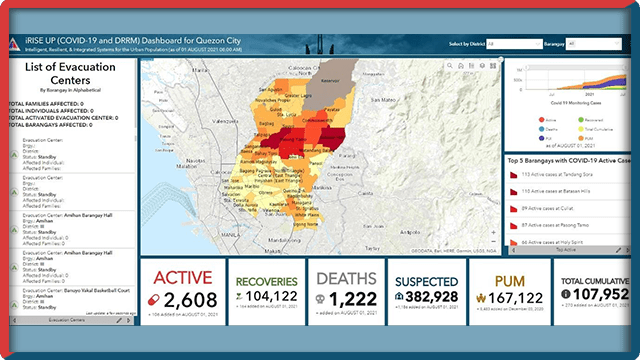
- INCIDENT RESPONSE BY QCDRRMO OPERATIONS AND WARNING SECTION
The Operations and Warning section is in-charge of all matters related to early warning systems, coordination of DRRM activities, and handling of all kinds of emergency services within the city’s jurisdiction.
Since its establishment, the QCDRRMO has demonstrated its capability to handle emergency operations and disaster response. In normal situations in which disaster response is not required from the Office, the QCDRRMO Rescue provides 24/7 emergency medical services and consequence management to incidents reported through the QC 122 hotline.
GAWAD KALASAG
The QCDRRM Council is a constant recipient of the Gawad KALASAG (KAlamidad at Sakuna LAbanan SAriling Galing ang Kaligtasan). Gawad Kalasag is a recognition given to local disaster risk reduction and management units for their efforts in the four thematic areas of DRRM. Since 2021, QCDRRMO received the Beyond Compliant Award. This means that QC have exceeded the standards for the establishment and functionality of the Local DRRM Council and Local DRRM Office for the past years.
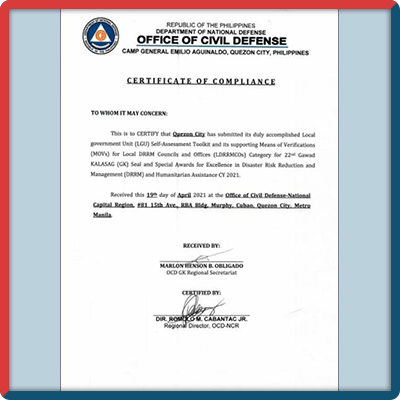
GALING POOK AWARD
The Galing Pook Awards as pioneering program that searches and recognizes innovative practices by local government units. Quezon City’s iRISE UP Program is one of the 10 awardees of the Galing Pook Awards
CLIMATE AND DISASTER RISK ASSESSMENT REPORT
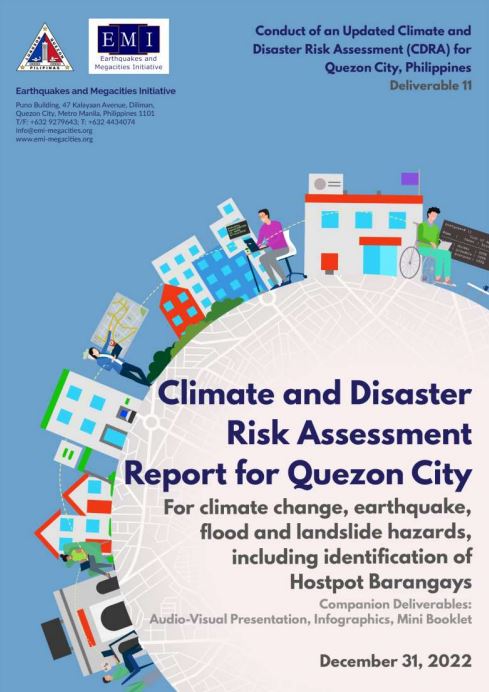
HAZARD, VULNERABILITY, AND RISK ASSESSMENT
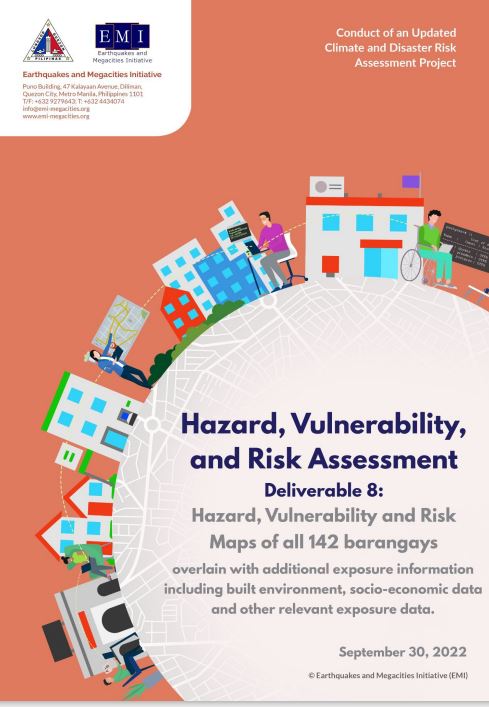
INFORMATION, EDUCATION, AND COMMUNICATION MATERIALS
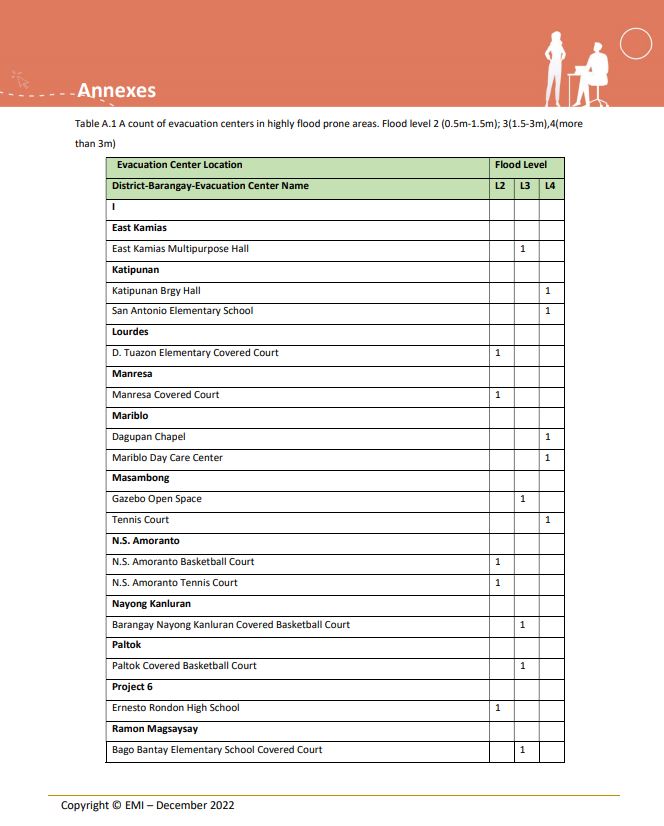
DOWNLOADABLE FORMS
Resources
QCDRRMO Citizen's Charter 2024
QCDRRMO Citizen's Charter 2023
QCDRRMO Citizen's Charter 2020
Quezon City Risk Atlas - January 6, 2014
Disaster Risk Reduction and Management Plan 2021-2027







